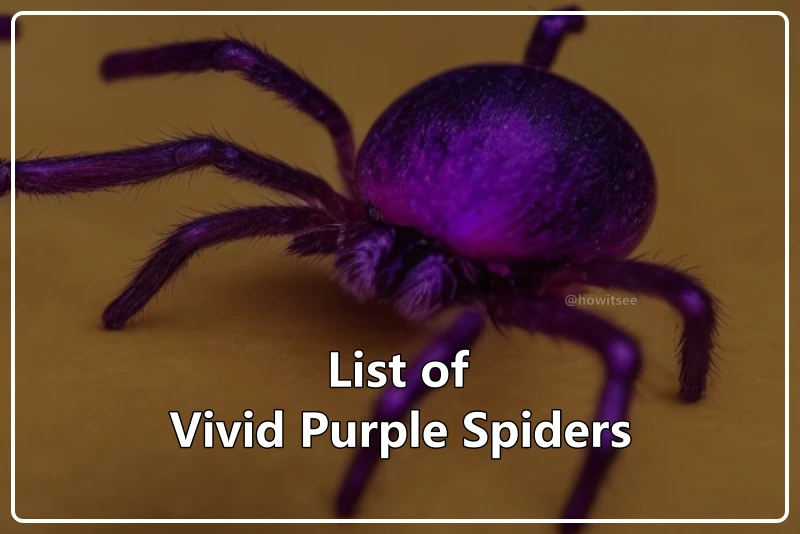Spiders are creatures that surely will not make you interested in them. They are arachnids belonging to arthropods that include other little creatures like scorpions, mites, ticks, and others.
On average, there are more than 45,000 species known living all over the world. With a big butt, eight hairy legs, and shiny eyes, spiders are magical.
However, they have the potential to make you die within seconds because of their creepy appearance, nobody dares to even touch them. Their presence around you is enough to make you freak out in seconds.
The contrasting colors with magnificent body designs will impress you a bit. Due you the presence of specific pigments in the body, spiders come in different color combinations like purple, black, blue, and multicolored. Let’s discover vivid purple spiders around.
Purple is such a nice color that will make you fall in love with it. Although not every spider on this earth will be creepy, some of them are adorable that will surely make you crave to touch them once.
The main question that arises in everyone’s mind is about their habitat, food, species, and danger level to humans and other animals present on Earth. So, without further waiting, let’s dive into this article.
13 Vivid Purple Spiders
1) Golden Baboon Spider
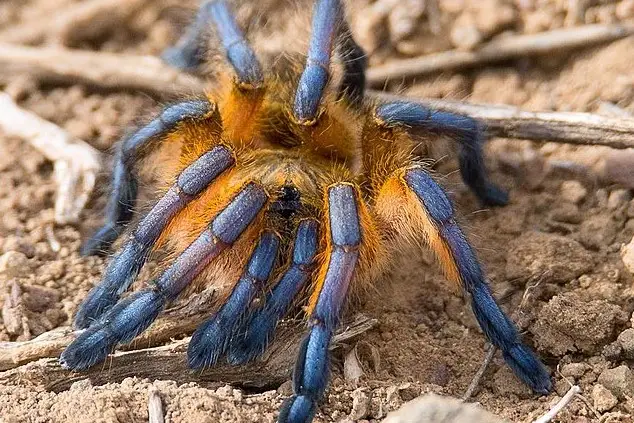
| Scientific Name | Harpactira pulchripes |
| Size | 0.13- 0.90 cm |
| Color | Multicolored |
| Location | Africa |
Another fascinating species of spider in the world will surely make you jaw-dropped. Introducing Golden Baboon Spider to the list.
The golden baboon spider is a native to South Africa that has become popular for trading with different countries of the world. The specialty of this species is that they burrow underground and attack their prey from their only.
The color of this species varies as per the angle and situation. Usually, the purple color is visible at the end of their legs and on their body.
2) Purple Tree Tarantula
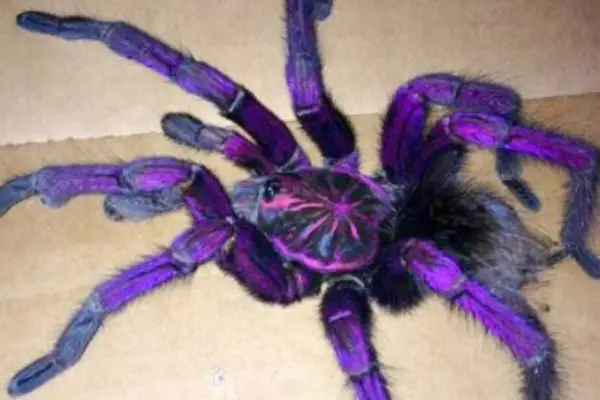
| Scientific Name | Avicularia Purpurea |
| Size | 13 cm |
| Color | Purple-Blue |
| Location | Amazon rainforests |
The purple tree tarantula is among the most beautiful specie of spiders you can find in the world. Coming from Ecuador, this species has the capability to live in a variety of habitats.
Although, this species can make you freak out within seconds after encountering it. From the cattle field to anywhere possible, you can witness their presence.
On average, this species can grow up to 13cm in leg length with an intense purple color and a hairy body. The urticating hairs present on the body are enough to irritate your skin. So, it is better to appreciate its beauty but from a distance.
3) Gooty Sapphire Tarantula
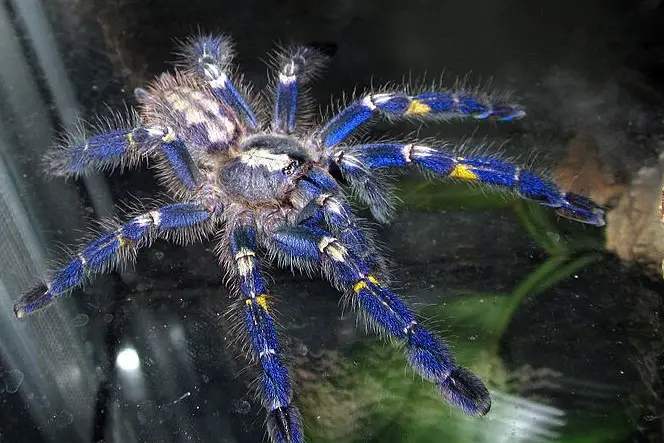
| Scientific Name | Poecilotheria Metallica |
| Size | 15.24 cm |
| Color | Red, Purple, Blue |
| Location | India |
Tarantula is one of those species in the world that shows heavy bodies with hairy legs and a unique coloration in their body. Gooty Sapphire Tarantula was born with a purple color that gradually turns into deep purple and sometimes even blue in color.
However, this species is not so much in size, yet the mesmerizing coloration of the body sets this spider apart from other species.
The bright coloration on its body reflects and bends intense lightning. You can easily spot this species dense forests of India.
However, one must keep in mind that tarantulas are irritant to humans, yet their beautiful coloration and appearance make them a popular exotic species.
4) Martinique Red Tree Spider
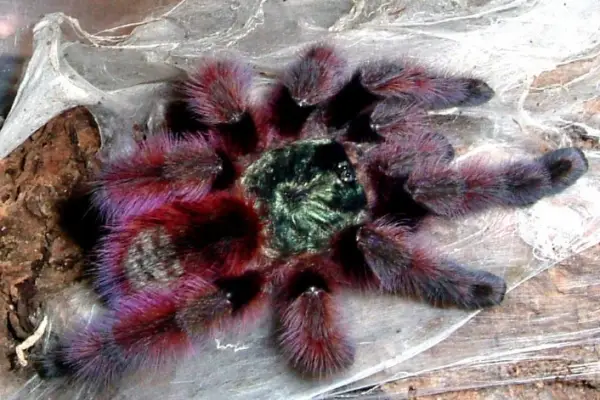
| Scientific Name | Caribena Versicolor |
| Size | 11 – 15 cm |
| Color | Purple-Red |
| Location | Caribbean, Martinique, and Lesser Antilles |
The antique-looking spider species with beautiful coloration, the Martinique red tree spider, is on the list. This ex*tic species of spider are a pro in making funnel webs that spend most of their time.
This species shows a bright color from the top that grows their abdomen to red in color. Overall, you will find every possible color on their body. They grow up to 15 cm and are harmless to humans. However, this species is enough to make you scared if it comes near you.
5) Madagascar Hermit Spider
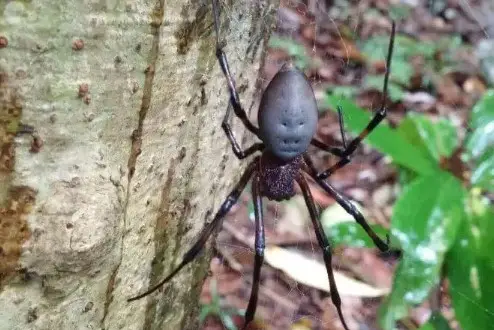
| Scientific Name | Nephilingis Livida |
| Size | 15-20 cm |
| Color | Purple, Black |
| Location | Madagascar |
Commonly found in Madagascar and islands nearby, the Madagascar hermit spider can be easily found in the world. The color of their body varies from gender to the age they belong.
Usually, this specie of spider will give you zombie looks as they have thin legs with almost strength by their looks. These species love to munch on mosquitoes, flies, and sometimes other small spiders around.
However, these species serve no harm to humans, and their mouth is small to bite human skin.
6) PurseWeb Spider
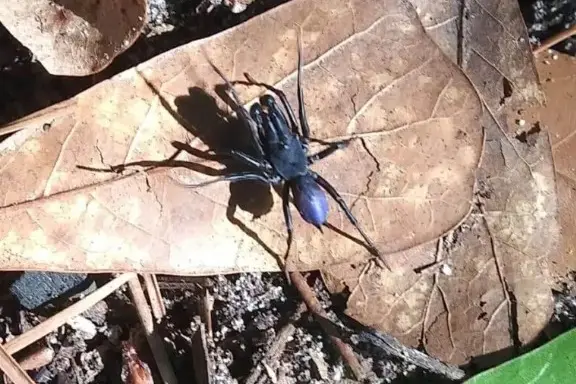
| Scientific Name | Atypus Affinis |
| Size | 1 – 3.8 cm |
| Color | Dark Purple |
| Location | Europe |
Belong to an Atypide Family, this species of spider is endemic in the United States. With a vibrant coloration on the body, this species is beautiful and unique. The blue abdomen in males attracts female spiders for mating.
You will always find their webs in the middle of a tree. This species is not harmful to humans; their painful bite can be dangerous. It is better to maintain distance from this species.
7) Chrysilla Volupe
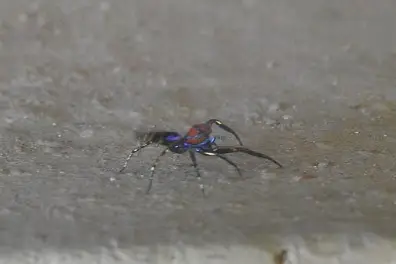
| Scientific Name | Chrysilla Volupe |
| Size | 0.261 cm |
| Color | Purple |
| Location | Sri Lanka, India, Nepal, and Bhutan |
Another species of spider found in the world with a vibrant purple color on its body, here is Chrysilla Volupe, a species of spider commonly found in Asia.
The coloration of their body makes them stand out among other species present on Earth. The presence of blue stripes o a red-orange body is mesmerizing, and for females, they show yellow legs. However, you can play with this species as they are not harmful but are small in size.
8) Purple Gold Spider

| Scientific Name | Irura Bidenticulata |
| Size | 0.5 – 0.6 cm |
| Color | Metallic purple, golden |
| Location | Thailand |
You have commonly discovered spiders jumping around. If this scene happens to you, you will run yourself to escape from it. The purple gold jumping spider is a newly discovered species found in Thailand.
This species is small in size and possesses fast jumping capability. Just a look at them is enough for you to admire their beauty.
Although their maximum length reaches 4mm, they are fun-loving spiders and absolutely harmless. Also, you will be able to find their jumping ratio four times more than their size.
9) Phormictopus Sp.

| Scientific Name | Hispaniolan Giant Tarantula |
| Size | 0.73 cm |
| Color | Black, Purple, and Brown |
| Location | Cuba and Hispaniola |
A boss-looking spider with thick hairy black legs commonly found in Cuba, this species is truly majestic. The hairs on their body are kicked as per the threats and can cause skin irritation if they feel threatened.
It is advised to maintain a permissible distance from this species as it can harm you easily.
With their age going p, they become bolder and flee. Don’t be surprised to get kicked by them if you try to irritate them.
10) Crab Spiders
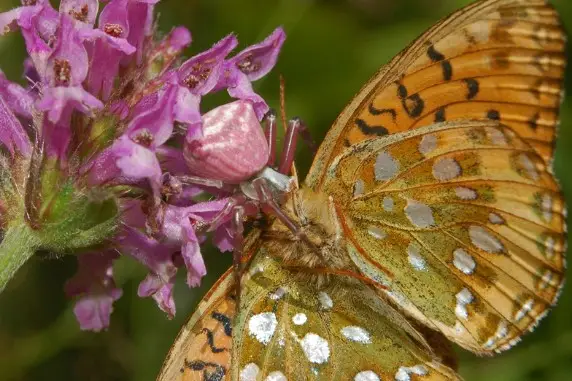
| Scientific Name | Thomisidae |
| Size | 0.12 cm |
| Color | Purple |
| Location | Australia, America, and India |
Do you know crab spiders are a unique species that can easily change their color based on the flower they live in? The best point to be noted about this species is its adherence to the flower they choose and waits for its prey on it.
This species of spider plays a crucial role in the food chain by eating out unwanted pests. Also, they show camouflage, unlike the chameleon.
However, this species is venomous, it is better to make a certain distance from it. Otherwise, it can harm you very well.
11) Golden Silk Spider
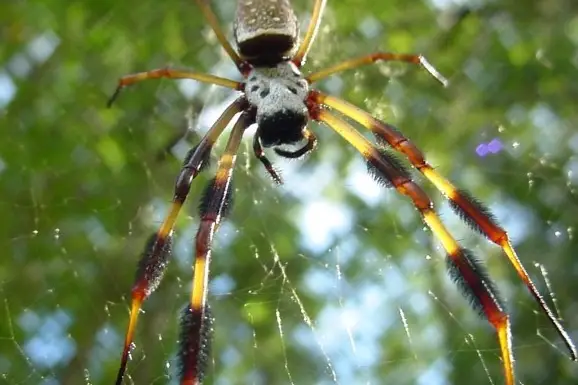
| Scientific Name | Tricho Nephila Clavipes |
| Size | 7.6 cm |
| Color | Purple and Golden |
| Location | Argentina and Peru |
A spider found in the United States and nearby countries, Golden Silk Spiders is among the most beautiful species you can ever discover in the world.
Hanging in a web with an elongated purple, yellow, and orange body— this spider strikes multi colorations on their body to produce different silks.
With its mesmerizing looks, this species is majestic and will surely make you want to touch it. However, always make sure that spiders come up with harmful responses.
12) Mirror Spider

| Scientific Name | Thwaitesia Argentiopunctata |
| Size | 0.3-0.4 cm |
| Color | Glazy Purple |
| Location | Australia |
A beautiful spider that resembles a shining rhinestone or a mirror, here is a Mirror spider, commonly known as a sequined spider that is small in size yet shows a vibrant appearance.
The color combination of this species includes a purple teardrop-shaped abdomen with thin legs. The mirror spider has the potential to change the coloration of the body as per the surrounding and any chances of threats.
13) Elegant Golden Jumping Spider
| Scientific Name | Chrysilla Lauta |
| Size | 0.5 cm |
| Color | Multicolored |
| Location | Burma, China, and Vietnam |
A robot-looking spider that is one of a kind looks like a psychedelic rainbow coloration of the body. It includes metallic blue, red, aquamarine, and a pinch of golden color on their body.
This species has an elongated scutum dipped in golden ink. The iridescent coloration of the body makes this species unique and beautiful.
14) Amazon Blue Bloom Tarantula
| Scientific Name | Xenesthis Intermedia |
| Size | 6-7 inches |
| Color | The Amazon Blue Bloom Tarantula has a deep blue-purple body with black hairy legs |
| Location | Amazon rainforest |
The Amazon Blue Bloom Tarantula’s mesmerizing blue and purple hue has inspired a unique and somewhat unconventional fashion trend among craftsmen.
Interestingly, the females enjoy a lifespan of up to 20 years, while the males typically live for a significantly shorter duration.
These tarantulas are known for their impressive burrowing abilities. They excavate tunnels in the substrate, creating underground homes for themselves.
When it’s time to find a partner, the males leave behind intricate silk trails and pheromones to attract potential mates.
15) Purple Crab spider
| Scientific Name | Epicadus heterogaster |
| Size | 2-11 mm |
| Color | Purple crab spider has a white body with distinct purple markings |
| Location | Found in various regions – Europe, North Africa, Turkey, Caucasus, Russia, Israel, Central Asia, Iran, China, Korea, and Japan |
With its stunning purple coloration, this arachnid is here to capture everyone’s attention with its pastel and serene color combination.
To attract unsuspecting pollinators, the spider’s abdominal protuberances reflect ultraviolet (UV) signals on its abdomen are thought to mimic the appearance of flowers.
The crab spiders exhibit a rainbow of hues, mostly as a way to camouflage in their surroundings.
16) Amazon sapphire pink toe
| Scientific Name | Ybyrapora diversipes |
| Size | 4.5-5.5 inches |
| Color | Amazon sapphire pink toe spider has a deep violet-purple body with pink hair distributed throughout the body |
| Location | Brazil |
The Amazon sapphire pink toe starts as a metallic silver, blue, and green spider with a bold red stripe, that transforms into a deep violet and blue beauty adorned with delicate pinkish hairs.
It has a unique defense mechanism. When threatened, they’re known to launch excrement as far as 2 to 3 feet away.
Amazon Sapphire Pink Toe Tarantulas are known to be extra sensitive to breezes. This means they require a carefully designed enclosure that minimizes drafts and provides the ideal humidity levels when considering them as pets.
17) Wolf Duran Giant Birdeater Tarantula
| Scientific Name | Pamphobeteus sp. ‘duran’ |
| Size | 7-9 inches |
| Color | It has a hairy brown body with purple-violet legs |
| Location | South America |
The Wolf Duran Giant Bird eater Tarantula is known for its relatively large size and distinct sandy-brown body with hairy purple-violet legs.
While they are not aggressive, they can be skittish.
With proper care and love, males can live for 4-5 years while the females outlive the males by a whooping 10+ years.
18) Gabon blue dwarf baboon tarantula
| Scientific Name | Heterothele gabonensis |
| Size | The leg span is about 4-5 inches |
| Color | The spider has a metallic blue sheen which is often viewed as purple or deep violet |
| Location | Central Africa |
The Gabon blue dwarf baboon tarantula is known for its stunning metallic blue sheen which looks more purple and violet when viewed at an angle.
Like the other individuals in the Tarantula family, Heterothele gabonensis, has tiny shiny purple-blue hair covering its entire body.
If you are planning to keep them as pets, it is important to mimic their habitat and provide them with utmost care.
Some pet enthusiasts also suggest whispering to your Gabon blue dwarf baboon tarantula to foster mutual respect between you and the spider.
19) Purple Tree Spider
| Scientific Name | Tapinauchenius violaceus |
| Size | About 4-5 inches |
| Color | The spider has a blue body that is entirely covered with violet and purple hairs, giving it a purple appearance |
| Location | South America |
The Tapinauchenius violaceus is particularly renowned for its captivating purple or violet coloration. They can be found leaping from branch to branch in their lush, green home among the canopies.
These tarantulas create intricate tube webs among the branches that not only provide shelter but also serve as a means for hunting.
The Tapinauchenius violaceus is nocturnal and hunts for its prey only in the night.
20) Brazilian pink toe tarantula
| Scientific Name | Avicularia juruensis |
| Size | Approximately 4-5 inches (sometimes growing up to 6 inches) |
| Color | It has pink feet with the abdomen showcasing different shades of purple, blue, and violet |
| Location | Brazilian |
The Brazilian pink toe tarantula boasts a velvety black coat of hair with vibrant pink legs that are sure to capture your attention.
They can be seen gracefully tip-tapping through the canopy, performing an elegant dance.
Like the other spiders we discussed, female Avicularia juruensis is known to outlive the males.
Brazilian pink-toe tarantulas are not picky eaters, accepting a variety of prey, including crickets, roaches, and moths.
Frequently Asked Questions:
1) Are there any real purple spiders?
Yes, there are real purple spiders, though not commonly found.
2) Are purple spiders poisonous?
Not all purple spiders are poisonous. While some spider species with purple coloration may be venomous, the coloration itself is not an indication of venomous properties.
3) Is there a purple and yellow spider?
Yes, some spiders have a combination of purple and yellow coloring. One of them is the Elegant Golden Jumping Spider (Chrysilla lauta), where males have a blue body with purple markings while the females have a wider, mostly purple and gold body.
4) Are purple-pink toe tarantulas poisonous?
No, purple-pink toe tarantulas are not considered highly venomous. While they possess venom, it is typically not dangerous to humans and rarely causes severe effects beyond local pain and discomfort. Their venom is primarily used to subdue their small prey.
5) What is the purple spider in the US?
The Purseweb Spider (Sphodros abboti) is a purple spider found in the United States. It is endemic to the state of Florida. They have black body with a purple back, and the males have a blue abdomen.
6) Are vampire spiders real?
Yes, vampire spiders are real. The vampire spider (Evarcha culicivora) is known to feed on the blood of other spiders. It is found in various parts of the world, including Africa, Europe, and North America.
7) Are rainbow spiders real?
No, rainbow spiders are not real. While the Peacock Spider (Maratus volans), native to Australia, closely resembles a ‘rainbow spider,’ there is no spider known as the ‘rainbow spider’ in reality.
8) What is the most toxic spider?
The Funnel-web spider is considered the most venomous spider due to its venom, which contains at least 40 different toxic proteins capable of shutting down the body’s nervous system.
9) Do rainbow spiders bite?
Spiders, including rainbow spiders, can bite as a means of defense or capturing prey. However, as discussed earlier, rainbow spiders do not exist.
10) What is the cutest spider?
Jumping spiders are often considered the cutest spiders due to their large eyes and curious behavior, often making people go ‘aww’.
11) What is the name of the rainbow spider?
Though only fictional, rainbow spiders refer to the group of spiders that showcases an array of colors on their body.
12) Do jumping spiders bite?
Yes, jumping spiders can bite. However, they are generally not aggressive or harmful to humans.
Conclusion
After going through detailed information about vivid purple spiders in the world, we came across various species in the world. These species are beautiful and show the unique design of their boy.
However, one must know well about their characteristics and habitats. A slight mistake in getting to know about them can really bring out unwanted danger in your life.
Spiders love to keep themselves away from humans, better is to respect this nature as it helps us in securing ourselves from these deadly little creatures.
References:
- Are There Purple Spiders? 8 Purple Spiders, by thepetenthusiast
- Purple Tarantula Animal Facts, visit: https://a-z-animals.com
- Wikipedia
Also Read:

Hi everyone, my name is Shawna, and I’ve always been fascinated by the fascinating diversity of flora and fauna that our nature has in it. I am currently studying biotechnology and am particularly interested in animal biotechnology, delving into the intricate processes that define their true nature and uniqueness.
